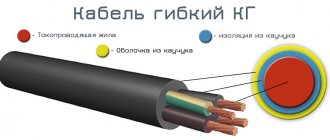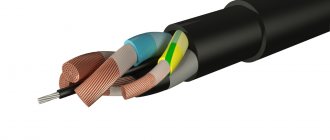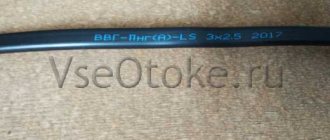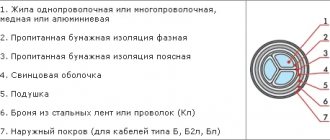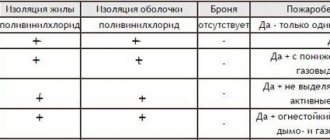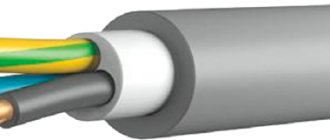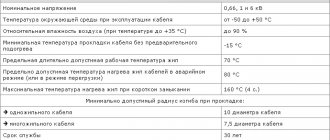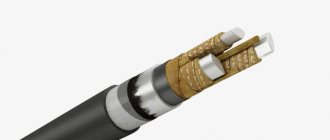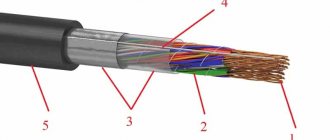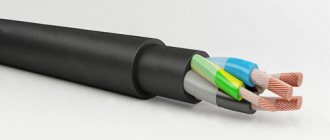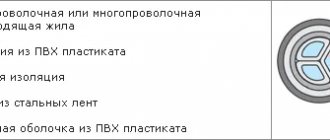KGVV cable design elements:
1. Current-carrying conductor - copper, stranded, round, class 4 or 5 with a nominal cross-section up to 10 mm2 inclusive, conductors with a nominal cross-section of 16 mm2 and above - classes 3, 4 and 5 according to GOST 22483. 2. Insulation - made of polyvinyl chloride plastic compound (PVC ). Insulated cable cores with a number of cores up to 5 inclusive have a distinctive color. The insulation of the neutral conductors is blue. The insulation of the grounding conductors is two-color (green-yellow). In cables with a number of cores of 7 or more, each layer has a counting core and a directional core that differ in color from each other and from the rest of the cores in the layer. 3. Twisting - insulated cable cores are twisted in concentric layers; insulated cores of four- and five-core cables can be twisted around a core insulated with PVC plastic. Three- and four-core cables have all conductors of the same cross-section or one conductor of a smaller cross-section (grounding or neutral conductor). Cables may have a grounding conductor with a nominal cross-section equal to the nominal cross-section of the main conductor. 4. Shell - PVC plastic
CS-CS.Net: Laboratory of the Electroshaman
Flexible power cables KGVV, LAPP OlFlex and KPL (elevator loop)
I continue the series of posts about specific cables. The previous post was about the most popular ones - KVVG and MKSh/MKESH (I compiled it from two old posts from early years). From that post we learned that there are multi-core cables with rigid cores with cross-sections of 1.5 or 2.5 square (for all kinds of power circuits, for example) and there are multi-core cables with flexible cores of small cross-sections (0.35..0.75 squares) for control circuits or other signals.
Now let’s talk about what to do if we need to make a flexible cable for 230V, but with 16A conductors (2.5 square cross-section)! The legs here grow out of the stage light (I can’t think of a more convenient example right now): you need to power the soffit or its individual parts. And you have to choose: whether to drag ten 3x2.5 cables or one 20x2.5 type in terms of convenience and compactness. And the cables must be flexible, because the soffit (truss) is periodically lowered on winches to replace lamps/adjust heads and so on... What should I do? Look for special cables!
What to do when you need a flexible cable with a cross-section of 2.5 squares? Damn, of course I'm going to screw the PVSin, right? )) And if there are five wires? Also PVSin. You can even find it in the form of 5x10! What if I lived on 7? Or at 14? Oops, but PVS can’t do that anymore. We are looking further!
The next thing everyone remembers is cables like KG or RPSh (previously RPSh cables were used to make cables for elevator cabins, if I correctly determined this from their appearance and childhood memories). But these cables have fucking rubber insulation not only on the outside, but also on the cores themselves. It gets damaged (pierced, scratched) more than PVC, and sometimes spoils (smears black) all sorts of surrounding objects. Cutting and connecting such cables is fucking sex!
And we would need... we would need to find cables that can be carried, rolled into coils, unwound again - and that these cables have such insulation that does not paint and does not stick to surfaces. And there are such cables! Of course, also with its own areas of application.
Flexible power cables KGVV and LAPP OlFlex (view of the cores)
Cables type KGVV: flexible power.
These cables have four advantages: long service life (30 years like VVG, and not 5 years like PVS), PVC insulation (like MKSh or PVS, which does not paint and does not stain anything), are produced with flexible cores and have there are a large number of them (7, 10 cores - easy, 14 cores - on order). And if desired, you can also use shielded versions: KGVVEV. Or flat - KGVV-P. Sections - from 0.75 to 6..10 squares. Just complete paradise, especially in terms of service life versus PVA!
I came across these cables in three situations: when one of my customers (a switchboard in Solnechnogorsk with IPM™) was laying cables from the main switchboard to others and realized that he had been putting it together: the pipes for the cables had long been walled up in the foundation and screed, and the rigid VVGhi they don't go there. So he asked me: “Is it possible to drag the KGVV through with lubricant.”
In two other cases, I myself dug flexible cables of a large (compared to MKSh) cross-section (1.5 and 2.5 squares) for a large number of cores, I remembered about KGVV from the case with Solnechnogorsk - and decided to order it for myself to try.
My practice has shown this: in Electrical Installation you can find KGVV up to 7 cores for sections from 0.75 to 6 squares, and in ETM you can find in the warehouse KGVV from 0.75 to 10 squares for 7..10 cores. Well! This is good and pleasant! Now you can again stir up all sorts of super-loops on harsh connectors =)
Cable type KGVV - power, flexible
I ordered KGVV 7x1.5 at Elektromontazh from the Brax factory (there was also Kolchugino to choose from), since with Brax all the wires inside the cable are colored, and with Kolchugino the wires are marked with color only for circular counting (as in KVVG/MKSh), with which I didn’t want to fool around. There's a ton of talc inside the cable and it's pouring out. The cable itself is very flexible and pleasant to the touch. I'm very pleased with it.
I used my KGVV in the IPM-E™ emulator for the generator and inverter connection cables. Here we just take it and solder it into the connector:
Soldering and assembling 2RM connector
And then we make a cable on this connector: flexible, the cross-sections allow you to carry a current of 10A (to load the shield).
Connecting a test cable (loop) to one of the panels to test its IPM
So far I have not found any other applications for this cable, but if someone wants to make replaceable wiring in baseboards or boxes, then you can pay attention to these cables in terms of service life. Another example of application is to make loops on these cables for control panels for cranes and hoists - but here you also need to think about how much the cable insulation will be damaged during operation. It seems to me that she will not live in conditions of a remote control from the hoist =)
LAPP OlFlex Classic cable: 12x2.5 =)
So at the beginning of the post I stuttered about the power supply blocks for the stage spotlights. And even in the post about the announcement of projects '2019, he wrote about blocks with sockets for his mini-stage. Now I will explain the whole idea, and then - when everything is finished - I will publish a post about these pads.
The idea is the following. All my stage lighting fits into one 16A machine. But I need to manage some parts of it separately. For example, turn on my lighting devices in parts: Wash heads, Spot heads, lasers and effects. I also have a couple of “duty light” spotlights - this is just illumination of the background of the room in the evenings, so that the contrast on the desktop and in the background is more or less the same.
And I need to turn all this on and off separately. Now a sausage made of five pieces of PVA is coming down from the ceiling. And in the theater I came across the idea of switching: a block with sockets is made (here is a post about it - I made it), to which one multi-core cable is connected to the connector. And through this cable, each socket in this block is controlled separately.
This is exactly what I need! And I began to look for a cable that could be easily ordered (it would be in stock at Elektromontazh or ETM, and it would be lowered in meters and not in 200-meter drums). At first I wanted a KGVV cable, but I needed a cable with 12 cores - and KGVV flew with it (and KGVV with 14 cores is already ordered in ETM and is not sold by the meter).
And then again rumors came to my ear about the LAPP plant, which is localized here in Russia and makes various cables, including specific ones. I started rummaging around and found the LAPP OLFLEX Classic 110 cable. It has 12 cores, 2.5 square meters each! Yyyy!!! This is what I need. And all such cables are sold in ETM by the meter, even if they are made to order at the factory!
Here, I dug up a catalog of these cables on the Internet: LAPP_OlFlex-Cables.pdf (7 MB) . In ETM, I chose a cable that was available in the warehouse and was not so wildly expensive (600 rubles per meter versus 1100).
My cable arrived and I immediately began trying it on the connector I wanted to use:
LAPP cable reel marking
The full designation of my cable is “LAPP Olflex Classic 110 12G2.5 Control cable 12x2.5 sq. mm.”
LAPP cable reel from factory (from Russia)
It looks like this:
LAPP OlFlex 2x2.5 cable for connecting power circuits (or control circuits)
What I liked about this is that the cable has a clearly defined PE core. That's it, you have nowhere to go: the cable must have PE, period! I also liked the fact that the cable is not so fat, despite 12 cores of 2.5 squares: its outer diameter is only about 16 mm.
The cable cores here are immediately marked with numbers from the factory, and in both directions: no matter how you look at the core, you will always see one of the numbers in a normal, readable position.
But I was a little disappointed with flexibility: my Classic 110 cable is a little stiff. KGVV is much more flexible in this regard - even more flexible than PVS. At first I was very upset, but then I accepted it: I can lower the cable along with the soffit, but I don’t care about the rest: most of the time they will be in a stationary position.
I ordered blocks with sockets (there are six Shuko standard sockets and two PowerCon type connectors at the end) and brutal connectors for them (there will be a post about this later) and in the future I plan to cut my 15 meters of cable into two pieces and connect them to these blocks via connectors .
Power distribution blocks (for my stage) to which the LAPP OlFlex cable will be connected
For a snack: cable type KPL (elevator cable cable).
I was rummaging around when I was looking for KVVG supplies for the first part of the post and found supplies of KPL cable - for elevators. I mentioned it once, but now I’ll take a photo of it and add it to the post as a bonus =)
Cool KPL cable for elevator cabin cables
Previously, for elevator cabins (old relay ones), cables were made from rubber-insulated cables (sort of like RPS), but now they are made from KPL. Here is information about it on the manufacturer’s website: https://firmapodij.ru/site/8. Cables are produced with 6, 12, 16, 18, 20, 24 cores of 0.75 square meters.
My cable contains 12 cores in three sets of four (one of them is PE, like LAPP) and is completely flat. In order to cut the cable to longer lengths, the cable contains rip cords (threads that cut through the insulation when pulled).
Cool KPL cable for elevator cabin cables (cores)
It’s cool to make cables from it for some moving parts of machines or equipment, when the flat cable must fit into some kind of guides along which the drive rolls.
The remains of the cable from the installation of the elevator (three pieces of 5 meters each) are lying around in my stock, and from this cable I only made a removable cable for one of the parts of my home switchboard in a 19″ case. Look, in the photo it comes out of the row of terminals and goes to the panel =)
Harnesses allow you to remove the shield without turning it off for servicing the BPS
Scope of application of the KGVV cable:
For fixed installation of power and control circuits on machines and mechanisms at voltages of 660 and 1000 V AC with a frequency of up to 60 Hz. The cables can be operated at voltages of 1000 and 1500 V DC respectively. For permanent installation with a bend radius of at least five outer diameters of the cable. Cables are not recommended for laying in the ground (trenches). Cables of the KGVV brand do not spread fire when laid alone. In the designation of cables with a zero core, the letter “n” is added to the brand. It is allowed to lay cables in the air, provided that additional measures are taken to protect against exposure to solar radiation.
Technical characteristics of the KGVV cable:
— Type of climatic modification of cables UHL, placement category 5 according to GOST 15150-69 — Operating temperature range: from -50°С to +50°С — Relative air humidity at temperatures up to +35°С: up to 98% — Laying and installation of cables without preheating, it is produced at a temperature not lower than: -15°C - Minimum bending radius when laying: 5 outer diameters. — AC frequency: up to 60 Hz — Test AC voltage with a frequency of 50 Hz (test duration 10 min): for a voltage of 0.66 kV — 3 kV for a voltage of 1 kV — 3.5 kV — Long-term permissible heating temperature of cable cores during operation: +70 °C - Construction length not less than: 100 m - Warranty period: 5 years from the date of commissioning of the cables, but no later than 6 months from the date of manufacture - Service life of the KGVV cable - 30 years.
KGVV cable is a flexible control cable with copper conductors, with a small twist pitch, in PVC insulation and sheath. Does not propagate combustion when laid alone. Designed for transmission and distribution of electrical energy in stationary installations in electrical networks at a voltage of 660 V alternating current with a frequency of up to 60 Hz or direct current with a voltage of up to 1000 V.
Price list
| Name | unit | quantity | price, m |
| KGN 2x0.75 | m | 95 | 26 |
| KG-660 2x10 | m | 281 | 106 |
| KGVV 10x0.75 | m | 58 | 68 |
| KGVV 10x1.0 | m | 28 | 73 |
| KGVV 27x0.75 | m | 45 | 238 |
| KGVVng-LS 27x0.75 | m | 3 | 217 |
KGVV cable design:
- The conductor is made of soft copper wires, at least class 5 according to GOST 22483.
- Insulation is made of polyvinyl chloride plastic. The cores are twisted into a core - the wires are color coded. Each layer of cables with a number of cores of 7 or more must have a counting core and a directional core that are different from each other and from the rest of the cores of the layer.
- The shell is made of PVC plastic.
Decoding of the KGVV cable:
K - control cable G - flexible B - PVC core insulation C - PVC sheath
Conditions for laying and operating the KGVV cable:
- for fixed installation of power circuits and control circuits on machines and mechanisms - for connecting mobile machines, mechanisms and equipment to electrical networks. - for stationary installations, they can be laid outdoors, subject to protection from exposure to solar radiation, as well as heat radiation from various types of heat sources. — for installation in cable structures and industrial premises. — group installation is permitted only in outdoor electrical installations and industrial premises, where only periodic presence of maintenance personnel is possible, and passive fire protection must be used. — for laying at a latitude of more than 65 °C without protection from solar radiation.
Number and nominal cross-section of KGVV cores:
| Number of cores in the cable | Nominal core cross-section, mm2 |
| 2 and 3 | |
| 4 | 0,5-6,0 |
| 5 | |
| 7, 10, 14, 16, 19, 27, 37 | 0,75-2,5 |
| 7 | 4, 6 ,10 |
Technical characteristics of the KGVV cable:
| For stationary installation the operating temperature is not higher than | 50 °C |
| For stationary installation the operating temperature is not lower than | -50 °C |
| For non-stationary installation of the gasket, the operating temperature is not higher than | 50 °C |
| For non-stationary installation of the gasket, the operating temperature is not lower than | 0 °C |
| Relative air humidity at temperatures up to 35°C up to | 98% |
| Laying and installation of cables without preheating is carried out at a temperature not lower than | -15°С |
| Long-term permissible heating temperature of cable cores during operation is no more than | 70 °C |
| Construction length not less | 100 m |
| Minimum bending radius of cables | |
| for stationary installation no less than | 5 design diameters |
| for non-stationary installation no less | 10 design diameters |
